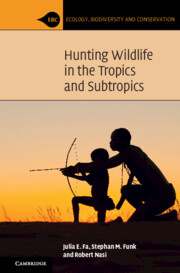There is no doubt that the hunting of wild animals for their meat has been a crucial activity that has transformed the evolution of humans, and it continues to be an essential source of protein and a generator of income for millions of Indigenous and rural communities in tropical and subtropical regions worldwide. Conservationists fear that excessive hunting of many animal species, particularly large-bodied ones, will cause further demise, as already witnessed throughout the Anthropocene. Many species of large mammals and birds have already been decimated or completely annihilated by humans overhunting them. If such pressures continue, many other species, even smaller-bodied ones, will meet the same fate. Equally, if the use of wildlife resources by those who most need them (i.e., the poor) is to continue, sustainable practices must clearly be implemented. More importantly, these communities must be enabled to become, or to remain, the custodians and managers of the wildlife resources within their lands, for themselves as well as for biodiversity in general. However, greater wildlife offtakes are now facilitated by the increased penetration of new lands by infrastructure, logging, mining and agriculture but also impacted by the emergence of new hunting technologies and by consumers in fast-growing urban centres demanding wild meat as a luxury item. More recently, the effects of zoonotic diseases linked to wild meat, including COVID-19, SARS and Ebola, have had devastating consequences on human health and economies worldwide and are likely to be a persistent threat to wildlife and its users in the future.
All available evidence points to the importance of hunting and use of wild animals for their meat by humans worldwide, and to the ways that overhunting (alongside habitat fragmentation) will impact future habitat composition and the provision of ecosystem services such as carbon storage. Our aim in this book is to present an up-to-date review of the vast amount of literature that has been published since the early 1980s. We focus on themes ranging from why humans hunt wildlife and who are the hunters, to what humans hunt and how they hunt, to the extent of hunting in different environments and how uncontrolled hunting can affect wild animal populations and the food security of those people who depend on wild meat. We also focus on how hunters make decisions to hunt their prey and on the thorniest issue – how do we measure hunting sustainability. However, although this is not a book to guide policy actions or teach us how to improve wild meat governance and management, because there are a good number of documents that deal with these more applied issues, we only touch upon this topic in our concluding chapter.
This volume is divided into three distinct themes. The first part includes two introductory chapters that outline the topic at hand as well as the environmental background where hunting of wildlife takes place in the tropics and subtropics. The second part collates information on the hunting process itself. We start by reviewing how human hunters hunt and examine the variety of techniques used in the past and present to take animals (Chapter 3). We show this not just as a record of how animals are taken by people but also as a testament to the ingenuity and resourcefulness that human beings have developed to feed themselves. This is followed by two chapters, the first explaining what we know about how hunters go about making decisions on how and what to hunt (Chapter 4), and a second that explores how we define hunting sustainability (Chapter 5). The third part of the book contains three chapters about the threats and drivers affecting wild meat use. A first chapter summarizes our understanding of how wild meat is consumed and hunted but more importantly what we know of the spatial and temporal impact of overexploitation of wildlife (Chapter 6). Here we also define defaunation and the consequences on prey populations and ecosystems. The following chapter deals with the currently topical matter of the variety of diseases in humans that can be or are linked to wild animals, especially when these are butchered and consumed by human beings (Chapter 7).We end the book with our thoughts on how we can bridge the gap between science and action (Chapter 8) and suggest ways of achieving this.
We want our book to be seen as a ‘go-to’ reference work that arguably presents the most extensive compilation of current knowledge on wild meat biology in one single volume. Despite the fact that we have placed our emphasis on examples from the tropics and subtropics, all or most of the subjects we deal with are generic in that they apply to other environments. They relate as much to hunting in the Arctic as they do to any environment around the world where hunting for food is still practised.
We have written this book with the student in mind, but it is meant to reach a wide audience, requiring no university science to understand it. The book should guide any reader by providing the basics required to understand all topics involved, by providing the elementary learning blocks for the uninitiated and a bolster to those with some background. Our wish is that this book can also be a source of inspiration for those wanting to work towards mitigating the threat of unsustainable use of natural resources. As John Robinson and Elizabeth Bennett alluded to, in their seminal book, Hunting for Sustainability in Tropical Forests, now over two decades ago, our quest for sustainability is like the allegory to pursuing the absolute in Lewis Carroll’s nonsense poem ‘Hunting of the Snark’, an elusive enterprise undertaken by a motley crew. We hope that through hard work and the good application of science, but always linked to an understanding of those communities that still rely on wildlife for food, this volume can inspire many to help come up with ways of ensuring a positive future for wildlife and people. Time is running out!!

